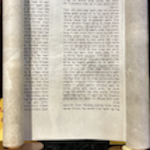I was excited beyond belief to learn that a long-lost manuscript was located by scholars in the Bibliotheca Alexandrina Antiquities Museum. The manuscript in question is the only partial copy we have of any part of the ancient text known as the Gospel of Peter. Hugh Houghton and Mina Monier have reported on this discovery and much more in an article, “Greek Manuscripts in Alexandria,” that appeared this month in The Journal of Theological Studies.
Here’s the relevant part of the article:
The most substantial Christian manuscript held in this collection is BAAM 0522. Its previous shelfmark was P. Cairo 10759, and it is also known as the ‘Akhmim Fragment’. A parchment codex, of which 33 folia are extant, this is the principal witness to the apocryphal Gospel of Peter and also contains chapters 1–27 of 1 Enoch, part of the Apocalypse of Peter and the Martyrium of Julianus of Anazarbus. Extensive attempts to locate this import-ant manuscript in 2010 failed—despite a note in the Leuven Database of Ancient Books that one page of the manuscript was on display in the Bibliotheca Alexandrina—with the result that Paul Foster notes in his critical edition of the Gospel of Peter that ‘the codex is now missing’. In February 2018, the authors not only saw two bifolia of this manuscript on display in the Antiquities Museum, but, after telephone permission had been granted from the Ministry of Antiquities, were shown the rest of the codex. This is stored in the metal cabinet immediately under the display case in which the selected leaves are on show, with each bifolium preserved between glass plates. The museum’s ownership of the document is confirmed by the database, which includes colour images of four pages. There do not appear to be any further Greek Christian documents in the collection: despite some inaccuracies in the database, this remains a very helpful tool for tracing papyri formerly in Cairo which are now permanently held in Alexandria.
I don’t know if readers of this blog will appreciate how exciting this sort of news is. We regularly lose things, and occasionally find them again, but rarely does a manuscript that has gone missing in this way turn up again.
Of course, many of you will know that I consider the Gospel of Peter to be particularly important. While I don’t think it literally contains the missing ending of the Gospel of Mark, I do believe it is influenced by that lost continuation more than we see in any of the New Testament Gospels (with the canonical Gospel of John also helping to fill in that story). You can read more about why I think that in the online article “Mark’s Missing Ending: Clues from the Gospel of John and the Gospel of Peter” in The Bible and Interpretation, as well as in my book The Burial of Jesus: What Does History Have To Do With Faith? published by Patheos Press.














